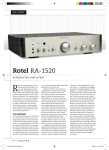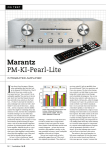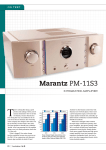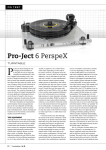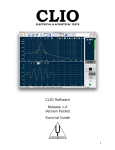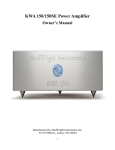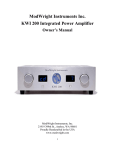Download ModWright Instruments KWA 100 Instruction manual
Transcript
ON TEST Modwright KWI 200 INTEGRATED AMPLIFIER U S company Modwright is owned by Dan Wright, which makes it pretty obvious where the ‘Wright’ bit came from, but if you’re wondering about what the ‘Mod’ bit means, it came about because Wright started out in business by modifying other manufacturer’s products. In fact he still does so, in the form of a number of highly-regarded modifications for the Oppo BDP-83, BDP-95, Sony XA5400ES and the Logitec Transporter, amongst other products. As many of his modifications involved substituting passive components such as capacitors, Modwright designed some of its own capacitors and now does a roaring trade in selling them to the DIY audiophile community. One of his most popular lines is a range of ‘M-Series’ capacitors that have oil-impregnated metallised polypropylene dielectrics and pure copper tinned leads. THE EQUIPMENT Dan Wright isn’t the only designer behind ModWright’s extensive range of power and integrated amplifiers and preamplifiers. He also commissions external designers, one of the most famous of which is none other than Alan Kimmel, creator of the vacuum 26 Australian Power Output: Single channel driven into 8-ohm, 4-ohm and 2-ohm non-inductive loads at 20Hz, 1kHz and 20kHz. [Modwright KWI 200] tube ‘Mu’ stage and designer of the world’s best modification kit for the Dynaco ST-70. According to Dan Wright, at the heart of the ModWright KWA 100 and KWA-100SE power amplifiers is a single voltage gain stage called the ‘Solid State Music Stage’ that was developed by Kimmel. I don’t know how much of Kimmel’s handiwork is incorporated in the KWI 200, but ModWright’s website says of the KWI 200 that it was ‘styled after the LS 100 and KWA 100SE in look and overall dimensions’ and that it, too, uses a ‘Solid State Music Stage.’ Perhaps most significant is that the ‘KW’ in KWI stands for Kimmel/Wright. Although the KWI 200 supplied to us for review was the basic offering—an integrated amplifier—it’s possible to optionally add a built-in DAC and dual MC/MM phono stages. The idea, according to ModWright, is that ‘the KWI 200 is designed to be the one-box solution for the modern age. Just add speakers and power!’ Before I opened the casing to check the internals, I thought the KWI 200 was very much an ‘old-school’ design, but it didn’t take long for me to discover that it’s anything but. For example, volume control is implemented not by a standard rotary potentiometer but instead via a digitally controlled analog volume control with a buffered input to the Solid State Music Stage. What is certainly ‘old school’ is that the KWI 200 has a hugely overdesigned linear power supply, at the heart of which is a massive 1.5kVA toroidal power transformer. Storage and smoothing is the domain of two capacitor banks that between them provide more than 234,000µF microfarads of fall-back power. The output stage employs four pairs of MOSFET devices per channel. Curiously, I could not see any of ModWright’s distinctive white capacitors Modwright KWI 200 Integrated Amplifier Power Output: Both channels driven into 8-ohm, 4-ohm and 2-ohm non-inductive loads at 20Hz, 1kHz and 20kHz. [Modwright KWI 200] on the PCB, so I suspect that at some stage in the future, we might see an ‘SE’ version of the KWI 200 appear in ModWright’s product line-up. Firing-up the KWI 200 will require a considerable degree of patience on the part of owners, because it takes almost a full minute for the amplifier to stabilise itself before it becomes operational, during which time you can’t do anything at all, not even change the input source. (Modwright says it takes 45 seconds, but I clocked my unit at a fairly consistent 53 seconds, so not quite a minute, to be entirely accurate.) To keep you occupied while you’re waiting—and more importantly to show that something is happening!— two horizontal bars in the blue digital volume display flash on and off. What the amplifier is doing during this initialisation period is checking for damaging d.c. at the input and output and also checking the temperatures registered by the various internal thermocouples, as well as for shortcircuits across the speaker outputs. According to Dan Wright, the protection circuitry he uses is unique to Modwright and sits entirely outside the signal path. He calls it ‘TSP’ which is short for ‘Total Silent Protection’. In the event that the TSP circuitry determines that something is amiss, the amplifier will shut itself down automatically and a rather cheeky ‘OOPS’ message will display for around 8 seconds.* If you’re unlucky enough to see this message, you should disconnect the mains power, check that your speakers are connected correctly, and that you don’t have a stray speaker wire bridging the (+) and (–) terminals, and then re-start the amplifier. Modwright also provides good old-fashioned analogue fuses as a back-up for the TSP circuitry, but they’re located inside the amplifier and should be replaced only by qualified technicians. (*The four letters are actually spread across the two displays, so the left-most display shows ‘00’ at the same time that the right-most one shows ‘05’, so unless you’ve read the manual—or this review—you might miss the humour.) Once you have fired-up the amplifier, and it has stabilised and switched itself on, you can use the left-most rotary control knob to toggle through all the available inputs on your particular amplifier. On mine, it went progressively through CD, L1, L2, L3. If you have the optional phono stage installed, it will then go through P1 and P2 as well. If you also have the optional DAC installed, you can also add D1 and D2 to that list of available inputs. After having chosen an input, you can then use the rightmost rotary control to adjust volume, which is accomplished in 99 discrete steps. Our review sample was one of the first off the line, and I was initially a little unhappy with the size of the steps, particularly at lower settings of the control. When I emailed Modwright, about this, Dan Wright replied and advised that he’d chosen the steps following listening sessions with speakers rated at 87dBSPL and 98dBSPL, and that following our concerns, he was re-calibrating the ON TEST MODWRIGHT KWI 200 INTEGRATED AMPLIFIER Brand: Modwright Model: KWI 200 Category: Integrated Amplifier RRP: $5,999* Warranty: One Year Distributor: Absolute Hi End Address: PO Box 370 Ormond VIC 3204 (04) 8877 7999 [email protected] www.absolutehiend.com *(With standard remote, see copy). • High power • Mute function • Valve warmth • Display dimming • Plastic remote • Owners Manual LAB REPORT Readers interested in a full technical appraisal of the performance of the Modwright KWI 200 Integrated Amplifier should continue on and read the LABORATORY REPORT published on page 90. Readers should note that the results mentioned in the report, tabulated in performance charts and/ or displayed using graphs and/or photographs should be construed as applying only to the specific sample tested. Lab Report on page 90 avhub.com.au 27 ON TEST Modwright KWI 200 Integrated Amplifier volume controls so that there was a more useable range in the lower range of the volume control, rather than simply 1dB per step, as it had been previously. Following this review, all KWI 200 models available will have their volume control settings adjusted so they correspond to the following output levels, referenced to rated output: 1 = –111.5dB 2 = –100.5dB 3 = –92dB 4 = –85dB 5 = –78dB 6 = –73dB 7 = –68dB 8 = –65dB 9 = –63dB 10 = –61dB 20 = –51dB 30 = –41dB 40 = –31dB 45 = –28.5dB 50 = –26dB 60 = –19.5dB 70 = –14.5dB 80 = –9.5dB 90 = –4.5dB (Note that in order to keep the above list shorter, I have abbreviated it so that it does not include all 99 possible volume level settings for the KWI 200’s volume control!). There are two buttons on the front panel of the KWI 200. The one on the left is the power switch. The one on the right is a ‘Home Theatre Bypass Switch’ that, if activated, disconnects the KWI 200’s preamplifier circuitry and sends whatever signal is connected to the HT/BP terminals on the rear panel directly to the KWI 200’s power amplifier stage. Because of this, I would recommend that you DO NOT attempt to use the HT/BP terminals as an extra ‘input’ and instead connect them only to a separate pre-amp or home theatre processor. This is also Modwright’s recommendation, which it makes clear in LARGE BLACK TYPE in its instruction manual. (Speaking of which, although the information in the manual is good, it’s not very well written, displaying a decided lack of the definite article.) Modwright provides extra features for the KWI 200, but they’re only accessible via the remote control(s). What? There’s more than one remote control? Yep. Modwright gives you the choice of either a plastic remote control or a metal one. The local Australian distributor, Absolute 28 Australian Hi End, supplied our review amplifier with the metal remote control… and what an object of beauty it is! Either of the two remotes will allow you to select input source, adjust volume and select HT/BP. Additionally, they’ll allow you to adjust display brightness (three brightness levels, plus Off), as well as mute and un-mute the output. As you can see on our photo, the remote has ‘Phase’, ‘Mon’, and ‘Bal’ buttons, but none of these apply to the KWI 200: they’re for use with other ModWright products. The ‘Trig’ button activates the two 12V d.c. trigger outputs on the KWI 200’s rear panel. Beautiful though this remote is, it will cost you an additional $229 on top of the base price of the amplifier. The rear panel sports gold-plated unbalanced RCA terminals for the CD, L1, L2 and HT/BP inputs, while the L3 input is serviced via balanced XLR connectors. The speaker binding posts are multi-way and gold-plated, and there’s also a pre-amplifier output, via gold-plated RCA terminals. The 12V trigger terminals (and note that both are OUTPUTS, not inputs) are the usual 3.5mm phone types. The 240V a.c. mains power socket is a standard IEC three-pin type, and is not integrally fused. Physically, the KWI 200 is neither small, nor is it lightweight. It’s 432mm wide, 153mm high and 432mm deep and weighs a shade over 28kg. This is fine if you’re putting it on the floor, but means you’ll need a fairly large, heavy-duty stand or rack if you’re not. In common with all Modwright products, the KWI 200 is made by hand entirely on the West Coast of the USA, at Modwright’s own private facility in the idyllic rural environment of Amboy, Washington. IN USE AND LISTENING SESSIONS Having heard from another reviewer that Modwright likes its amplifiers to have a 200hour warm-up, I obliged, but I found that as night fell, the display was ‘way too bright. ‘No worries’, I thought, I’ll just turn the displays off via the remote. So I turned the displays off… only to discover that those huge engraved ‘MW’ initials on the front panel are back-lit, and that they don’t turn off (or even dim) in concert with the two digital displays. In retrospect, I can see that this enables you to see that the amplifier is switched on, but at the time it seemed a little weird. Once the 200-hours had elapsed, I rushed to fire up one of my current favourite albums, the curiously titled ‘From the House of Master Böhm’ from Melba Recordings, which features one of Australia’s best-known Power Output: Single and both channels driven into 8-ohm, 4-ohm and 2-ohm non-inductive loads at 20Hz,1kHz and 20kHz. harpsichordists, John O’Donnell, playing works by Georg Böhm (1661–1733). Initially, I was embarrassed that I’d never heard of Böhm, much less listened to anything he’d written which, when I read the liner notes, proved even more embarrassing when it turned out he’d been a major influence on my all-time musical hero, Johann Sebastian Bach. Indeed it appears that J.S.B. may for a time have been apprenticed to Böhm and for a time in his teens actually lived in the Böhm household. But as I read the notes further, I realised I had heard of Böhm and indeed as a child played one of his most popular works, the Menuet in G, because it’s included in the Clavierbüchlein für Anna Magdalena Bach, which I had learned from beginning to end as a young piano student. Although the Menuet in G (Track 7) is my sentimental favourite on this disc, and I’m ON TEST Modwright KWI 200 Integrated Amplifier captivated by all the works on it, I was blown away by the Praeludium in G Minor, which is simply amazing, for both its concept and execution. I can do no better than quote O’Donnell’s liner notes, which say in part: ‘its striking opening section, in particular, seems to lack either predecessors or successors. The lyrical theme of the central fugue is worked out effortlessly at considerable length, while the closing section showers us with descending broken chords, often harmonically unexpected.’ As you’d expect of O’Donnell, who is an exponent of Bach and world-renowned as both an organist and harpsichordist, his playing is crisp and wonderfully precise (and a harpsichord is unforgiving if you’re not!), perfectly revealing the attributes of the score that he described in words. I was amazed by the expression O’Donnell was able to imbue in the music—far in excess of what I’ve heard from any other exponent of the harpsichord. No doubt he was aided by a marvellous instrument, built by William Bright in 1995, the sonics of which have been captured perfectly by Melba, but all credit to O’Donnell—his playing is exceptional. I had the volume of the KWI 200 turned up ‘way too high for realistic harpsichord reproduction, so I was really forcing the amplifier to produce both the transients and the sonorities, but the Modwright responded effortlessly. The amplifier was also able to reveal those essential but elusive ‘silences between the notes’ thanks to an ultra-low noise floor, and the sense of me being able to hear the venue’s acoustic was uncanny. Needless to say, if you love music, you should buy this disc. It seems incredible that were it not for the fact that J.S. Bach (and his children) made copies of Böhm’s scores, most likely for academic purposes, the works on this disc may have been lost forever. As you’ll hear for yourself, that would have been a tragedy. Recognising that the harpsichord is not a popular instrument, even amongst keyboardists, I auditioned the KWI 200 with my full gamut of ‘discs that I use for evaluation’ so that there was barely an instrument that I didn’t hear during the weeks I had the KWI 200 on loan… though I did draw the line at banjo and harp. I also made sure I listened to everything from solo instruments (and voice) through to orchestral and choral works. Never once in all my listening to all these genres did I hear the KWI 200 set a foot wrong, no matter whether I was listening at whisper-quiet levels in the dead of night, or annoying the hell out of my neighbours on sunny weekend afternoons by playing rock ‘n roll at rock concert levels. Modwright’s KWI 200 took everything in its stride, delivering note-perfect reproduction without raising so much as a sweat… as if saying ‘is that all you got? And, where one would expect such a powerful amplifier to excel at dynamic realism (and it did), the KWI 200 also excelled when it came to microdynamics as well, with not even the smallest musical details escaping its attention. And where some high-power amplifiers can sound a little harsh, and some solid-state amplifiers can sound a little too clinical, neither description was true of the Modwright, whose sound I found was more akin to that of a valve amplifier, with a definite warmth and fullness of sound across the audio spectrum. The spectral balance was, in general, excellent, with no one part dominating over the other but I found that the spectral balance did alter subtly but quite audibly depending on what loudspeakers I connected to the KWI 200, so that with larger, floorstanding loudspeakers with a low impedance there seemed to be a little more ‘bloom’ in the bass than there was in similar models with higher impedances, or with stand-mount designs, so in this area as well, the Modwright’s performance is also reminiscent of valve designs, where correct speaker selection is so essential in achieving the desired sound quality. My sessions were made much easier by the useability of the KWI 200’s remote, and particularly because the up/down controls on the remote worked magnificently well, adjusting volume quickly and smoothly and instantaneously, making operation from the listening position a true delight. It turned out that Dan Wright is one of those very few designers who has the good sense to make the ‘Mute’ control work exactly as it’s supposed to work, so that the amplifier will unmute itself automatically if you touch either of the volume buttons on the remote, or the volume control on the front panel. My only regret was that the remote’s curvy exterior meant I could not stand it on its end on the coffee table alongside my listening chair. CONCLUSION As mentioned previously, the KWI 200 loaned to me for this review didn’t have the phono and DAC options fitted, and so I couldn’t help wondering if I’d option them in if I were buying this amplifier. I’ve decided that I wouldn’t, and that I wouldn’t even if they were available for free! I liked the KWI 200 just the way it is, so I’d personally recommend you buy the plain, basic KWI 200. It’s a great amplifier: powerful, well-built, and greg borrowman honest. LAB REPORT ON PAGE 90 30 Australian LAB REPORT Modwright KWI 200 Integrated Amplifier CONTINUED FROM PAGE 26 TEST RESULTS Newport Test Labs’ measurements of power output showed that Modwright’s power output claims (assuming they were intended to apply when both channels were driven) were met only at a frequency of 1kHz, where the amplifier delivered 221-watts per channel into 8Ω and exactly 400-watts per channel into 4Ω. When reproducing a 20kHz signal, the KWI 200 managed only 180-watts when driving 8Ω loads, and 306-watts when driving 4Ω loads. The differences are academic, of course, as you can see by the dBw figures, which show that the difference between an output of 200-watts and one of 180-watts is just 0.5dB—too small to be detectable by any human ear. If Modwright’s specification was actually for just a single channel driven, then the KWI 200 easily met its specification into both 8Ω and 4Ω loads except when the test frequency was 20kHz and the load was 4Ω, in which case it was only able to deliver an output of 361-watts. Newport Test Labs also tested the KWI 200’s power output into 2Ω loads, for which the amplifier isn’t rated at all, and the Modwright was able to deliver 800-watts at 1kHz with a single channel driven, and 602-watts per channel at the same frequency when both channels were driven. What’s more significant is that it was able to deliver almost the same power levels at frequencies as low as 20Hz, which indicates the use of a very high-quality power supply. Frequency response was superbly extended, with Newport Test Labs measuring Modwright KWI-200 Integrated Amplifier - Power Output Channel Load (Ω) 20Hz (watts) 20Hz (dBW) 1kHz (watts) 1kHz (dBW) 20kHz (watts) 20kHz (dBW) 1 8Ω 220 23.4 234 23.7 200 23.0 2 8Ω 210 23.2 221 23.4 180 22.5 1 4Ω 420 26.2 422 26.2 361 25.5 2 4Ω 390 25.9 400 26.0 306 24.8 1 2Ω 760 28.8 800 29.0 544 27.3 2 2Ω 578 27.6 602 27.8 450 26.5 Note: Figures in the dBW column represent output level in decibels referred to one watt output. Modwright KWI-200 Integrated Amplifier - Test Results Test Frequency Response @ 1 watt o/p Frequency Response @ 1 watt o/p Channel Separation (dB) Channel Balance –1dB 1.0Hz – 190kHz –3dB 88dB / 66dB / 42dB 0.02 (20Hz / 1kHz / 20kHz) dB @ 1kHz THD+N 0.4% / 0.4% @ 1-watt / @ rated output 80dB / 84dB dB referred to 1-watt output Signal-to-Noise (unwghted/wghted) 98dB / 106dB dB referred to rated output Output Impedance Damping Factor Australian Units/Comment 2.2Hz – 180kHz Signal-to-Noise (unwghted/wghted) Input Sensitivity (CD Input) 90 Measured Result 37mV / 500mV (1-watt / rated output) 0.7Ω OC = 11 @1kHz V Power Consumption 1.95 / 83 watts (Standby / On) Power Consumption 107 / 664 watts at 1-watt / at rated output Mains Voltage Variation during Test 242 – 251 Minimum – Maximum LAB REPORT Modwright KWI 200 Integrated Amplifier the 1dB downpoints at 2.2Hz and 180kHz, and the 3dB downpoints at 190Hz. Channel balance was excellent, at 0.02dB. Channel separation was good at low and midrange frequencies, as you can see from the tabbed results, but diminished to just 42dB at 20kHz. Output distortion levels were moderately high, as you can see from the spectrum analysis that’s shown in Graphs 1 through 4. At an output of 1-watt (Graphs 1 and 2) you can see that into 8 ohm loads, the 2nd, 3rd and 4th harmonics were at levels of –48dB, –50dB and –60dB respectively, equating to percentage distortions of 0.39%, 0.31% and 0.1% for each of the distortion components. Low-order distortion is perceived by the human ear as being euphonious, and most experts say that low-order distortion levels of less than 3.0% are not audible in any case. With this in mind, you can see that the overall one-watt/8Ω THD+N level was measured at 0.4%, as shown in the tabulated results. As you can also see, distortion dBFS 0.00 increased further when the amplifier was driving 4Ω loads, with the second and third harmonics sitting just below –40dB (1.0%) distortion and the fifth, sixth and seventhorder harmonics all above –70dB (0.03%). Distortion levels increased again when the amplifier was operating at rated output, as you can see in Graphs 3 and 4. This time, harmonic distortion components are spread right across the audio spectrum, with the odd-order harmonics generally 10dB higher than the even-order harmonics, but with all harmonics generally constrained to between –60dB (0.1%) and –80dB (0.01%). You can see from the ‘grass’ on the noise floor around the individual harmonics that the KWI 200’s power supply is operating right at its limits. You can also see that the noise floor is right down at around –130dB for the most part, though increasing to –100dB at very low frequencies. The overall signal-to-noise ratio of the KWI 200 was measured at 80dB unweighted and 84dB A-weighted referred to Newport Test Labs -20.00 -40.00 -60.00 -80.00 -100.00 -120.00 -140.00 0.00 Hz 4000.00 8000.00 12000.00 16000.00 20000.00 Graph 1: Total harmonic distortion (THD) at 1kHz at an output of 1-watt into an 8-ohm non-inductive load, referenced to 0dB. [Modwright KWI-200] dBFS 0.00 Newport Test Labs -20.00 -40.00 -60.00 -80.00 -100.00 -120.00 -140.00 0.00 Hz 4000.00 8000.00 12000.00 16000.00 20000.00 Graph 2: Total harmonic distortion (THD) at 1kHz at an output of 1-watt into a 4-ohm non-inductive load, referenced to 0dB. [Modwright KWI-200] 0.00 Newport Test Labs one-watt, and 98dB unweighted and 106dB A-weighted referred to rated output. The frequency response of the Modwright KWI 200 across the audio band is shown in Figure 5 both into a standard laboratory 8Ω ‘dummy’ load (a high-power non-inductive resistor) and when the amplifier is driving a simulated loudspeaker load (Newport Test Labs uses the circuit developed by Ken Kantor as modified by John Atkinson, of Stereophile). You can see the response into the 8Ω load is essentially ruler-flat, being just 0.1dB down at 20Hz and 0.2dB down at 20kHz. Note, however, that the response is shown to be rising above 20kHz. There was far more variation in the response when the amplifier was driving the simulated load, so that the response was 20Hz–20kHz ±0.4dB, again with a rising output at high frequency. This result suggests the KWI 200’s output impedance was quite high, and indeed it was measured at 0.7Ω, for a damping factor of 11. CCIF-IMD was high, with highlevel intermodulation components clustered 0.00 Newport Test Labs around the two high-20.00 level test frequencies (at 19kHz and 20kHz) -40.00 and a regenerated 1kHz -60.00 signal at –55dB (0.17%). Interestingly, this graph -80.00 looks as though it could -100.00 have come direct from a valve amplifier, rather -120.00 than a solid-state design— particularly as regards the -140.00 0.00 Hz 4000.00 8000.00 12000.00 16000.00 20000.00 regenerated 1kHz signal. Graph 4: Total harmonic distortion (THD) at 1kHz at rated output (400-watts) into a 4-ohm non-inductive load, referenced to 0dB. [Modwright KWI-200] The square wave dBr oscillograms indicate that 1.00 Newport Test Labs although the frequency response across the audio 0.50 band is flat, and that the amplifier can easily accommodate highly 0.00 reactive loudspeaker loads, its frequency response rises at ultrasonic frequencies. -0.50 The Modwright KWI 200 integrated amplifier proved -1.00 to be fairly power-hungry 10.00 Hz 100.00 1000.00 10000.00 30000.00 Graph 5: Frequency response of line input at an output of 1-watt into an 8-ohm non-inductive load when it’s operating and (black trace) and into a combination resistive/inductive/capacitive load representative of a typical two-way loudspeaker system (red trace). [Modwright KWI-200] will draw around 100-watts from your mains power Newport Test Labs supply in day-to-day use— even when it’s on but not being used—but potentially can pull 664-watts. In standby mode, the draw is less than 2-watts, but I would still recommend you leave the amplifier switched off when you are not using it. Steve Holding dBFS 0.00 -10.00 -20.00 -20.00 -30.00 -40.00 -40.00 -50.00 -60.00 -60.00 -80.00 -70.00 -80.00 -100.00 -90.00 -100.00 -120.00 -110.00 -120.00 -140.00 0.00 Hz 4000.00 8000.00 12000.00 16000.00 Graph 3: Total harmonic distortion (THD) at 1kHz at rated output (200-watts) into an 8-ohm non-inductive load, referenced to 0dB. [Modwright KWI-200] 92 Australian 20000.00 0.00 Hz 4000.00 8000.00 12000.00 16000.00 20000.00 24000.00 28000.00 Graph 6: Intermodulation distortion (CCIF-IMD) using test signals at 19kHz and 20kHz, at an output of 1-watt into an 8-ohm non-inductive load, referenced to 0dB. [KWI-200]







